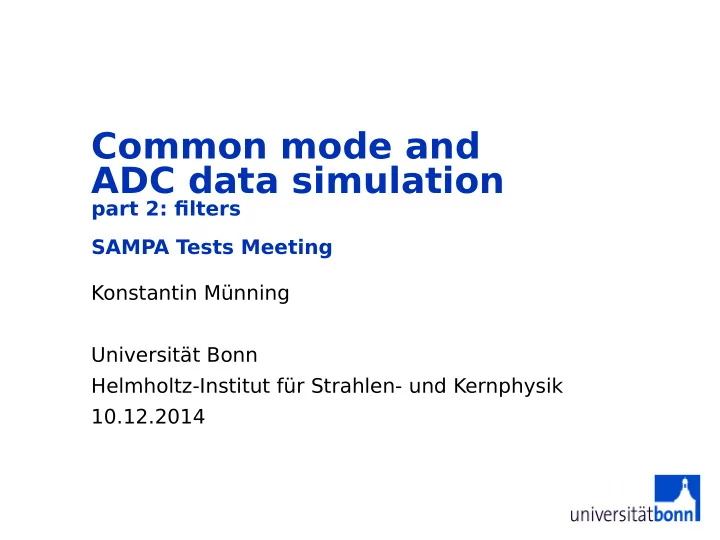

Common mode and ADC data simulation part 2: fjlters SAMPA Tests Meeting Konstantin Münning Universität Bonn Helmholtz-Institut für Strahlen- und Kernphysik 10.12.2014
Simulation of common mode efgect • the simulation of the common mode efgect is based on superposition of all charges arriving at the pad plane attenuated by the capacitive coupling factor • the baseline shift is a result of the pile-up of the charge signals • at suffjcient rate this shift and its fmuctuations become signifjcant 2
Filtering • to reduce the impact of the baseline shift a digital fjlter, the baseline correction circuit, has been implemented in the data path of the ALTRO chip: from ALTRO manual DRAFT 0.2, CERN 2002 • Filter performance needs to be evaluated for an optimal choice for the upcoming SAMPA chip 3
Evaluation • to evaluate the quality of the fjlter a measure of its efgect is needed • approach: using well known input signal spectra and measuring the resulting deterioration due to the baseline shift and fmuctuations without and with fjlter • here: single line spectrum of peaks with 60 ADC amplitude and 160ns peaking time with random time distribution • evaluation of peak areas • comparison with ideal values and theoretical values 4
Parameter extraction • usually peak parameters are extracted by pulse shape analysis → without proper selection and tuning results may be misleading • as the data is simulated using the intrinsic information when peaks signals are generated is the most reliable peak identifjcation • overlaps and peak multiplicity can easy be detected ROI overlap peaking time of 160ns, signal amplitude 60ADC, pedestal 10ADC simulation without common mode efgect with 10MHz sampling rate 5
Peak areas without common mode analytical value • ideal condition, just the peaks, no common mode • peak area is calculated in a fjxed region relative to peak synthesis time • reference for best achievable result with this setup 6
Peak areas with common mode analytical value • impact and magnitude of baseline shift on peak area is clearly seen 7
AL TRO Moving Average Filter • average of 8 samples • upper and lower threshold set to 4 ADC • baseline is restored for all tested charge rates • constant overcorrection depends on threshold value 8
Alternative: slope based fjlter upward slope downward slope simplifjed functional description of slope based fjlter • slope based fjlter is following directly the signal but is limited by maximal slopes for rising and falling • has some advantages compared to ALTRO MAF 9
Slope based fjlter • upward slope 1/20, downward slope 1/1 • baseline is restored for all tested charge rates • lower noise • slight overcorrection depends on charge rate and slope parameter 10
Direct fjlter comparison 11
Hypothesis • fjlter quality can be measured by comparing the restored baseline to the analytical baseline value difgerence to analytical value analytical value 12
Conclusion • with given parameters both tested fjlters efgectively remove the baseline shift • advantages of moving average fjlter: well tested, known behavior • advantages of slope fjlter: lower noise, easy to implement in hardware → low energy consumption, self-healing → no start-up sequence needed • results of baseline comparison support hypothesis → easier method to analytically evaluate fjlters • discussion of fjnal fjlter choice necessary 13
Further steps • add formulas and numbers • optimize parameters, try known threshold values, try with realistic peaking times • use random signal amplitudes or specifjc spectra • add noise and distortion • simulate with fast changing charge rates • add PSA and try recorded detector data • Further more exotic tests are also possible like straying random bit fmips in the fjlter registers to simulate radiation induced errors 14
Comments? Questions? 15
Spares 16
Data reduction with slope based fjlter peak amplitude peak start peak area • slope based fjlter allows data reduction by easily extracting peak parameters by on-chip DSP • instead of transmitting ADC values, only few data words need to be transmitted • data amount is not scaling with ADC sampling rate • easy correction of missing areas/amplitudes • new noise/zero suppression schemes possible 17
fjne structure of peak parameters • when restoring peak parameters from digital data with simple means, i.e. without fjtting functions, a fjne structure is revealed when the amplitude resolution is not limited 18
Recommend
More recommend